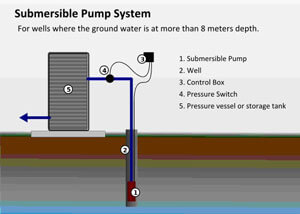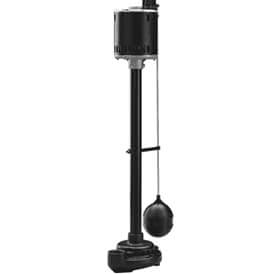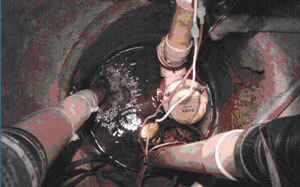Sump pump
Not all buildings need sump pumps, but over 90% of American homes have either had to deal with a leaky basement, or they are currently suffering from moisture related issues involving mold and mildew, which can pose significant health risks, including: headaches, respiratory problems, asthma attacks, coughing, skin irritation and rashes, allergies, or cold and flu-like symptoms.

A sump pump's primary job is to keep buildings dry, so they're typically installed in the lowest part of a home's basement or crawl space, and are designed to discharge water away from sanitary sewers. Older installations that discharge to sanitary sewers, as in connections to a laundry sink, may now violate current plumbing codes because these types of connections can overwhelm a municipality’s sewage treatment system.
If your house smells musty or feels damp, you may have a moisture problem. Over time, a wet basement can substantially ruin virtually everything you store there, plus destroy floor and wall coverings. Coupled with other waterproofing systems, such as a French drain, exterior waterproofing membrane, or a dehumidifier for humidity control, a sump pump provides protection to your possessions and improves the quality of the air you and your family breathe.
How a Sump Pump Works
Sump pumps are usually installed in a pit or hole in the deepest area of your crawl space or basement, and as water fills that hole, the pump activates, moving that water via pipes away from your foundation. To prevent water from flowing back, those pipes are normally designed with check valves.
Most pumps are activated either via pressure sensors or float activators similar to those in toilet tanks, but you can buy manually operated pumps that only work when turned on. Most automated pumps have an option to manually activate them should their sensor or float arm fails.
Importance of Having a Dry Basement or Crawl Space
- Improved indoor air quality
- No mold or mildew growth
- Increased property value
- Safe, dry place to store belongings
- Usable area that can be finished
- No water stains on floors and baseboards
- Prevents pest infestations (termites, roaches, mosquitoes, etc.)

Types of Sump Pumps Available
The two most common home sump pump designs are submersible and pedestal pumps. Both utilize standard household electrical connections, but since the pumps are either in or near water, they should be connected to a ground fault circuit interrupter (GFCI) outlet to prevent accidental electrocution.
Submersible Sump Pumps
Submersible pumps are encased in a waterproof housing as they sit in the water with the outlet pipe near the top. When this type of pump activates, water is drawn through a grate on the bottom of the pump and then routed out of your home.
Pedestal Sump Pumps

Pedestal pumps are designed to draw water from the sump pit via an inlet pipe. The actual pump rests above the pit which makes them louder by design, but also less expensive.
Options Available With Your Sump Pump
When you're trying to decide which sump pump to install in your home, there are quite a few options available. The most common to select from:
- The length of the cord: You will need to be able to plug your sump pump directly into a GFCI outlet. Never plug your pump into an extension cord.
- The horsepower of the motor: The horsepower you'll need depends on the severity of your basement seepage problem. Sump pumps normally come either with one-quarter to one-third horsepower.
- Convenience: While manually operated pumps are typically less expensive, automatic pumps are much more convenient.
- The voltage of the circuit: Unless you're installing a pump to handle an industrial type of application, 110 volt circuits are common for residential installations.
- The pressure necessary to lift water out of the sump pit: A sump pump's efficiency can be measured by its ability to raise water to a specific height, known as its head pressure. A sump pump with a head pressure of 10 feet should lift water to that height less ten percent.
What if You Lose Power to Your Home? – Understanding the Importance of Backup Sump Pumps
Sump pumps won't help to rid flood water from your basement if you lose power, so a backup system is highly recommended. Fortunately, back up battery sump pumps are commonly available. Most systems continuously charge the backup battery while the power is on, so they'll be fully charged in the event of a power outage. Whereas you could opt for a car battery, a deep cycle battery like those used in outdoor and marine applications can be deeply discharged over and over, and they're specifically designed to provide a steady amount of power for sustained periods of time.
Backup diesel or gasoline generators are also an option. Gauge the necessary wattage of the generator to both start and operate your specific sump pump. Even small pumps can draw close to 2000 watts when starting and require nearly 1000 watts to operate.
Sump Pump Maintenance

A sump and its basin must be properly maintained. It’s suggested that you have your sump inspected at least one time per year. However, if the sump runs regularly because of a high water table, it is recommended that the unit be examined more frequently.
Since sumps are mechanical devices, they can experience problems with parts, including check valves, float switches, and discharge lines. It is not uncommon for these parts to eventually wear out or experience problems with obstructions getting in the way and preventing them from working like normal. Even a partially obstructed discharge line can cause the sump to work much harder than normal, and this could cause it to overheat and breakdown.
Float switches and check valves must also be clear of obstructions from within the tank and lines. A float guard can be installed to prevent the switch from staying on the pump’s housing unit and remaining “activated” or in an on-position.
Common Problems With Sump Systems
- Unit is handling heavy volumes of water and is constantly running.
- Sump is clogged with dirt or debris.
- Switches to the unit are clogged – float switch.
- Discharge lines are clogged or frozen.
- Power to the unit is lost – system may be unplugged.
- Sump runs very loudly.
- Pit or basin has a foul odor.
- Float switch isn’t working.
